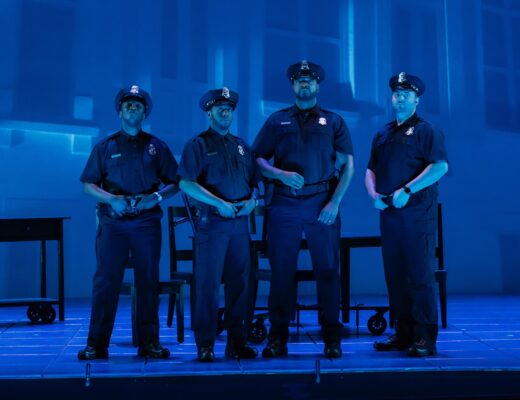By Ilena Peng
This article was first published in The DC Line here.
Mariinsky Ballet’s Paquita — on stage for the past week at the Kennedy Center — combines new choreography with that of its 19th-century predecessor in an updated production that maintains the same grandeur and classical technique that defined the original.
The first performances of the ballet Paquita occurred in Paris in 1846 with choreography by Joseph Mazilier, but the well-loved versions still performed today are based on a Paquita choreography by Marius Petipa that premiered the next year. The Mariinsky’s Paquita at the Kennedy Center since Tuesday is a new-millennium Paquita inspired by the Petipa iteration but infused with choreography by Mariinsky dancer Yuri Smekalov.
One can conceive of the relationships between these two Paquita choreographies as something like the difference between the Lurman movie Romeo + Juliet starring Claire Danes and Leonardo DiCaprio and a version of the same story performed by the Royal Shakespeare Theatre. Somewhat confusingly, while retaining some of the traditional choreography, this new Paquita produced by the Russian-based company incorporates elements of Miguel de Cervantes’ novella La Gitanilla, about a teenage girl born into an upper-class family who was kidnapped as an infant by gypsies.
Both the original and new Paquita culminate in a glittering Act III Grand Pas wedding celebration, which is the only part of the Mariinsky’s new production that retains Petipa’s original choreography (with reconstruction and staging by Mariinsky’s Yuri Burlaka). Paquita is one of a handful of 19th-century works that have become synonymous with ballet. Giselle, another mainstay of the classical ballet repertoire, will be performed by the American Ballet Theatre at the Kennedy Center in February.
Maria Khoreva is a stunning Paquita, embodying the character’s youth both in her exuberant onstage energy and her actual age — Khoreva is only 19, having risen to the rank of first soloist in just her first season at the Mariinsky. DC balletgoers first met Khoreva when she performed the lead role in Le Corsaire at the Kennedy Center last year.
Yet Khoreva’s Paquita is also mature and independent — she commanded the stage Friday night in her ability to convey emotions from joy to despair in the first two acts and in her third-act portrayal of Paquita as both sophisticated and free-spirited.
The athleticism of the Mariinsky’s leading men seemed at times more than human, including seemingly effortless turns and jumps where the performers appeared to hover in the air. Konstantin Zverev’s portrayal of the male protagonist, Andrés, was notably elegant and was most expressive in Act II alongside Khoreva in the jail scene; Zverev’s pathos and sadness were palpable. Victor Caixeta, as the poet Clemente, commanded the audience’s attention early in the ballet with an Act I variation where his grand jete series sent him nearly floating across stage in a tuxedo tailcoat.
Smekalov’s choreography retains the same sense of grandeur as the Petipa Paquita but with added humor (including two dancers who donned a horse costume). Signs of the Mariinsky’s traditional technical style were evident throughout, including a focus on expressive upper-body movement, made eye-catching by colorful capes and skirts.
The Russian dancers’ acting skills were impeccable, allowing a narrative to be conveyed to the audience more clearly than in many similar performances. Particularly effective performances in this regard came from Maria Bulanova as Carducha, Alexander Romanchikov as the young man, and Elena Bazhenova as the old woman who raised Paquita. The ballet opened with Paquita being kidnapped by Bazhenova, who triumphantly lingered to show the audience her victory before scurrying offstage. Bulanova was convincingly jealous of Paquita in Act II, and Romanchikov maintained his relaxed demeanor into his bows, drawing laughs from the audience.
Maria Shirinkina stood out throughout the show as Paquita’s friend Cristina, most notably in her Grand Pas variation. Anastasia Lukina’s and Yana Selina’s Grand Pas variations were also exceptionally elegant.
Smekalov’s new Paquita is part of an ongoing trend of reinterpretation of the classical story ballet. Area audiences may have seen what’s become a local holiday tradition — The Washington Ballet’s Nutcracker, choreographed by former Washington Ballet artistic director Septime Webre and set in a Georgetown mansion with George Washington as the heroic nutcracker. American Ballet Theatre artist-in-residence Alexei Ratmansky is reconstructing/re-creating several 19th-century ballets, part of an ongoing conversation about tension between innovation and preservation of classical ballet.
The Mariinsky describes this Paquita as a modern “homage to the golden age of classical ballet — a mark of respect and gratitude” to Petipa. Taken in its entirety, the Mariinsky’s Paquita succeeds as a gimmick-free yet modernized display of classical technique.





No Comments